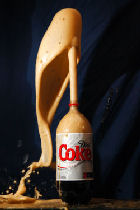
Purpose
To demonstrate how carbon dioxide gas in soda can cause a volcanic eruption when mixed with mentos candy.
Additional information
Carbon dioxide, a colorless and odorless gas, is the chemical compound made up of two oxygen atoms bonded to a single carbon atom. Carbon dioxide can be found in soft drinks and soda water to give the beverage it's "fizz".
Sponsored Links
Required materials
- 1 Roll of mentos mint candies
- 2-liter of bottled diet or regular soda (note that diet soda erupts higher than regular soda)
- A narrow test-tube that's about the circumference of the mentos or a funnel wide enough for the mentos to fit into. You may also use a narrow piece of paper to fold into a tube.
- Index card
Estimated Experiment Time
Less than 5 minutes to set-up, only a few seconds for the eruption.
Step-By-Step Procedure
- 1. Place your mentos candies inside the test-tube or funnel so that they're stacked one on top of the other in a single column. If you don't have a suitable test-tube, you can roll a piece of paper into a narrow tube just wide enough to fit the mentos into.
- 2. Place the index card over the mouth of the test-tube or paper tube on the top end. Invert the test tube (flip it over) so that the index card holds the candies from falling out.
- 3. Open the two liter of soda by removing the cap and shake the bottle a little.
- 4. The eruption will happen very quickly, so make sure you're prepared. Place the rolled candies from the tube over the bottle opening, index card down. Remove the index card so that the candies will fall into the bottle in one smooth motion.
- 5. Stand back and watch your volcano erupt, shooting jets of soda several feet into the air!
Note
You'll want to conduct this experiment outdoors in an open area. Your volcano may shoot several feet into the air and things WILL get messy! Also, make sure you use a 2-liter bottle with the mint (white) mentos for the best eruption.
Observation
Do you think a similar reaction would occur if you were to use other candy, such as M&Ms?
Result
When the mentos candy is dropped into the carbonated soda, which is filled with carbon dioxide gas, the gelatin and gum arabic from the dissolving candy create an energy that breaks the surface tension of the soda. The pits around the surface of the candy act as nucleation sites, which are conduits for carbon dioxide bubbles to form. Once the mentos hit the soda, bubbles immediately begin to form on their surface. When the candy hits the bottom of the bottle, the gas is released and pushes all the soda from the bottle up in the air in an amazing eruption!
Sponsored Links
Take a moment to visit our table of Periodic Elements page where you can get an in-depth view of all the elements,
complete with the industry first side-by-side element comparisons!